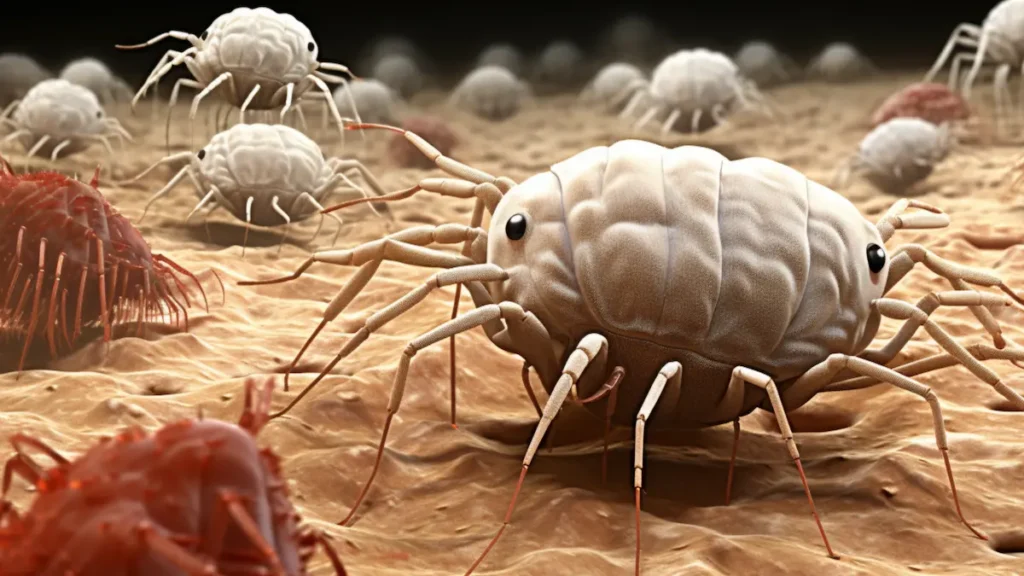The name Mites groups a very large group of tiny arachnids (just a few millimeters in length), which are among the oldest known terrestrial creatures, given that there are fossils almost 400 million years old—for example, dust mites, ticks, and red mites.

Distributed in both terrestrial and marine habitats, as well as in urban and domestic contexts, they are mostly predators and parasites. However, some variants feed on plants and organic waste matter (detritophagous). They often cause illness and happiness in humans and other animals.
Although about 50,000 species of mites are described, it is estimated that between 100,000 and 500,000 are yet to be discovered.
Mite Characteristics
Mites are classified in the class of arachnids, which is why they share some morphological characteristics with animals such as spiders and scorpions: a more or less segmented body covered with a chitin exoskeleton, four pairs of articulated legs and a pair of chelicerae (pincers) used for feeding. In parasitic variants, these appendages are adapted to gnaw through the skin and suck blood or other vital substances.
The mite habitats They are, as we have said, very varied, being able to find them even at a depth of 5000 meters in the sea; however, it is common to find them in our homes, housed in carpets, stuffed animals, blankets and bedding, as they feed on the pieces of dead skin left by our bodies.
They are also common in the fur or plumage of numerous animals and insects. Some variants can become agricultural pests or cause contact-transmitted diseases, such as scabies (psoriasis).
Types of mites
According to their diet, we can also distinguish between four forms of mites:
- Parasites. They feed on the skin or blood of animals, including humans, causing damage and skin diseases.
- Predators. They feed on microorganisms, small arthropods, or other smaller arachnids.
- Detritophages. They feed on organic waste left by plants and other animals, such as scales, pieces of skin, hair, etc.
- Phytophages and mycophages. They feed on plants, vegetables, and fungi.
Dust mite allergy
Most mites are usually harmless. However, their droppings and the bodies of dead mites are among the main causes of common allergies and asthma in humans. The usual symptoms of said allergy include sneezing, congestion, runny nose, cough, watery eyes, and/or skin redness.
Normally, the correct one is recommended room ventilation, avoiding the accumulation of moisture, as well as regular cleaning with hot water (over 60 ° C) of carpets, plush toys, and bedding, as well as regular exposure of mattresses and pillows to the sun.
Examples of mites
- Dust mite. The “common” mite is normally harmless but can be linked to respiratory and skin allergies. It can be found anywhere in our homes, on sofas, cushions, and carpets, where they feed on organic waste. They are part of the domestic ecosystem.
- Scabies mite. The cause of the scabies is a disease that afflicts man and other mammals, causing hives and sores on the skin. These mites dig tunnels within the outer layers of tissue, where they feed and lay their eggs, preventing wounds from healing properly. This disease can be transmitted from one living being to another with the simple contact of their skin, but it usually requires poor hygienic conditions to thrive.
- Ticks. The well-known ticks, which parasitize various forms of mammals (cattle, dogs, cats) and can even feed on humans, are a form of large parasitic mites. They are nuisance animals and carriers of lethal diseases, such as typhus, Lyme disease, or certain forms of nerve palsy with just their bite.
- Bird louse. These mites are hematophagous (they feed on blood), parasitize birds, especially poultry, and can sometimes increase to the point of causing anemia in the animals whose blood they feed on. It is common to find them in chickens, turkeys, and animals that are raised in large numbers since, in these cases, they can pass from one animal to another and keep the infection alive.
- Red mite. Scientific name Panonychus ulmi, this phytophagous mite is typical of fruit trees and is considered a typical summer pest. They usually hibernate in the form of an egg and emerge in spring on the underside of the leaves, which, because of this, tend to dry up and fall.
- Red spider. Sometimes confused with the red mite, the Tetranychus urticae is also a common pest of fruit trees, present in more than 150 plant species of agricultural importance. It is usually located on the underside of the leaves, where it weaves a kind of spider web (hence its name).
- Cheese mite. This mite commonly attacks cheeses that have been stored for a long time: its presence is noted as a greyish, floury coast, where live mites, their eggs, and feces are found. Contact with these mites can cause dermatitis in humans.
- Warehouse mite or weevil. Another form of domestic mite, which usually appears in the cupboards, feeds on flour, pasta, and other forms of vegetables for culinary use or on the forms of fungus originating in them. Some variants, like Glycyphagus domesticus or Suidasia medanensis are capable of causing allergies in people.
- Scab mite. This mite, which affects the crops of about 30 edible plant species, from the vine to the pistachio, is commonly known as scab in the agricultural regions of Spain. On the leaves, they are recognizable by the black (necrotic) dots that they leave along their veins, but they can infect any green area of the plantation.
- Soil mite. These animals are among the most numerous, scattered on the floors of forests, meadows, or any ecosystem, providing them with abundant organic matter to degrade. In this sense, they are a vital part of the transmission cycle of matter and make up the lowest link in the food chain.
